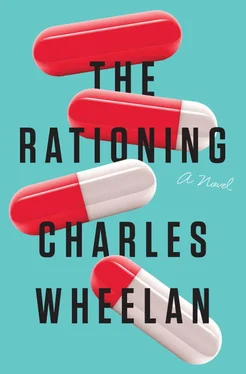Ellen was understandably eager to talk about what was happening. She was curious about the work I had been doing, and, like everybody else, she wanted to know how worried she should be about Capellaviridae. “I get it now,” she said, which I took to be an all-purpose apology for our squabbles in recent days, most of which had to do with my absences and general lack of attention. I wanted to sleep more than anything else, but I realized I owed Ellen at least a cursory discussion of the situation. “You met the President?” she asked.
“Just about every day,” I said.
“What’s he like?” she asked. I did my best to describe the President and the other senior officials with whom I had been interacting. Ellen had relatively little curiosity about my work but great interest in the people I had been doing it with. If I had been less exhausted I might have been more charitable, but I remember wondering if Ellen was going to have me describe their outfits, including the designers.
At about this time, I got a short text from Jenna: “Did you see the ice cream cone thing?”
“Sorry,” I said to Ellen. “I have to reply to this.” I felt awful in that moment, knowing I had exploited the situation to flirt with someone I had known for less than twelve hours. At the same time, I realized—and Jenna would later tell me that she had realized—that those three hours beginning on the bench were more than just three hours on a bench. Jenna was the person I wanted to be speaking to at that moment. I texted back: “Amusing but also a reminder that the guy with antivenom gets the ice-cream cone!” In hindsight, this was not as clever as I thought it was. (I have no future career with the Onion .) I went to bed thinking about Jenna and knowing that I should have been thinking about Ellen. But that is not the larger point here. I also went to bed with the German mad scientist on my mind. I remember thinking, The guy with the antivenom gets the ice-cream cone! was the kind of chippy thing Professor Huke would say.
In fact, it was exactly the kind of thing that Huke would say. Because it finally got me thinking like a virus (after eleven more hours of sleep).
THE PRESIDENT AWOKE SHORTLY BEFORE AIR FORCE ONE touched down in Canberra. The exuberance of his exciting takeoff to the west had dissipated; the senior staff realized there was no plan once they arrived in Australia. As expected, the Chinese had made a new offer via the U.S. Embassy in Beijing, but they were still demanding that the U.S. walk away from the South China Sea Agreement, as well as an array of other unacceptable concessions. The press—both on board Air Force One and back home—had moved beyond the U.S.-China showdown and were asking the right questions: When would the Dormigen supply be exhausted? Who would be given priority as the supply ran out? And what would be the public health implications? The President asked for basically the same information upon landing. The Chief of Staff gave him a short briefing. “The Dormigen supplies have been secured,” she said, consulting the notes on her yellow legal pad. “We have tightened the prescription criteria so that no one is getting Dormigen who does not absolutely need it. That seems to be working okay.”
“Cecelia Dodds?” he asked.
“She’s still in intensive care. It’s a nasty infection. She’s tough and they’re doing what they can.”
“Tell me if she gets worse.”
“I will.”
“What about this high school principal in Arkansas?” the President asked, waving a copy of his daily press clips (a compilation of news stories from around the world that the White House Press Office felt would be of interest to the President). The Washington Post–USA Today had run a front-page story about a fifty-three-year-old man who arrived at a hospital with failing kidneys. He was correctly diagnosed with a raging kidney infection. He also had a serious heart condition that got less attention. Per the new guidelines, he was started on a traditional antibiotic rather than Dormigen. The infection responded to the antibiotic, as doctors had hoped, but his failing kidneys put unexpected strain on his heart and he died of a heart attack. The man, Paul Gannett, was a prominent member of the local community and his death had been a shock. Hence the national news story.
“He should have gotten Dormigen. It’s going to happen,” the Chief of Staff said. “Even that may not have saved him.” The President nodded in acknowledgment and she continued. “At the current run rate, the Dormigen supply will be exhausted in about five days.”
“How many deaths?” the President asked.
“The low end of the projection is now forty-five thousand.”
“What’s the top end?”
“A hundred and fifty.”
“Jesus.”
The Communications Director had been sitting in on the meeting. He interjected, “The NIH has been working up some new numbers. There is a way to dress up the figures—”
“They’re dead. How do you dress that up?” the President snapped.
The Communications Director, impervious to the President’s tone, continued. “Most of the projected deaths are people who are already old or ill.”
“So they don’t count?”
“Kind of. I was talking to one of the senior guys at NIH. He explained something to me that’s kind of intuitive, if you think about it. Most of these people were going to die anyway, right?”
“Get to the point,” the President said wearily.
“If we measure incremental deaths over a longer period of time, say a year or two, the number is going to be a lot lower.” The President frowned, took a bite of toast, and said nothing. The Communications Director continued, “The number of deaths will spike when we run out of Dormigen, but then the death rate will be below average for the next three to six months. That means over the next year, the number of incremental deaths will be much, much lower—close to zero.”
“People aren’t really being killed by the epidemic, they’re just dying early,” the President said sarcastically. “Why don’t you call Cecelia Dodds’s grandchildren and explain that to them? ‘She won’t be at your wedding because she died early.’”
“This is straight from the NIH,” the Communications Director said defensively.
The Chief of Staff said, “People are going to go to the hospital, they’re going to be denied Dormigen, and they’re going to die. It doesn’t matter how we tally the deaths, that reality is not going away.”
The President added, “Maybe Hallmark can do a new card: ‘Sorry for your loss, but she was going to die in the next twelve to eighteen months anyway.’ I can send one to the Dodds family.”
“I’m just trying to get through today,” the Communications Director said, displaying some impatience of his own.
The cable news stations had developed fancy graphics and names for the crisis: the Dormigen Countdown; the Dormigen Debacle; and so on. The new NIH projections had not leaked, but some of the old ones had. The media had a decent idea of when the Dormigen supplies would run out, as well as a crude projection for the virulence of Capellaviridae. Overall, their estimates were not wildly wrong, no doubt because some of the concerned scientists on our team were feeding information to the press. The President also suspected the Speaker had been strategically leaking information to create support for the China option before that deal blew up and made her collateral damage. In any event, the public would soon have a more refined sense of the situation. Congress had (rightfully) demanded a full briefing on the situation. With the President in Australia, the Acting HHS Commissioner was tapped to do the congressional briefing. That briefing would be private, but anything said in there would leak immediately. The Communications Director recognized the White House needed to get out in front of the leaks to put its own spin on the situation. (Hence his reference to just getting through the day.) The President would do a national television address immediately after the “closed” congressional briefing.
Читать дальше












